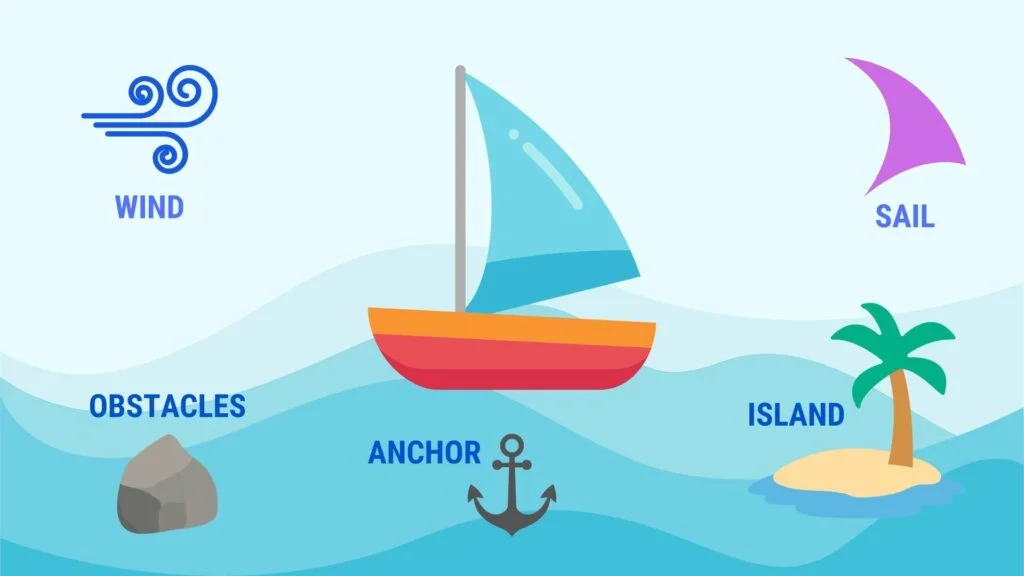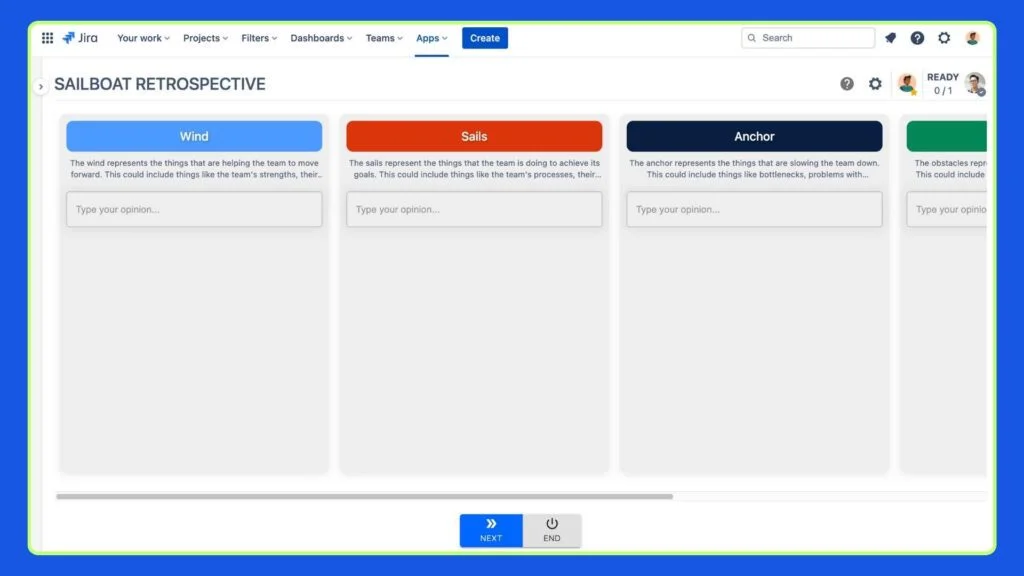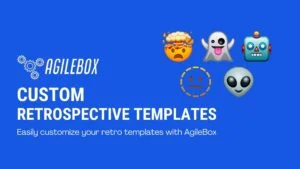Welcome to the world of Agile retrospectives and the innovative Sailboat Retrospective. In this journey of reflection and improvement, your Agile team becomes a crew on a sailboat navigating the seas of project development. Just as sailors gather on a ship’s deck to review their voyage, your team comes together to discuss how your project journey has been.
About the Sailboat Retrospective
Imagine your Agile team is like a ship on a journey through the vast sea of project development. The Sailboat Retrospective is a special kind of meeting where your team reflects on its recent journey. Just like sailors gather on a ship’s deck to review their voyage, your team comes together to discuss how things went during the project.
The name “Sailboat Retrospective” is fitting because it represents the idea that your project is on a journey, just like a sailboat, and you want to adjust your sails to reach your destination.

The elements of the Sailboat Retrospective are as follows:
- Wind: The wind represents the things that are helping the team to move forward. This could include things like the team’s strengths, their resources, and their positive attitude.
- Sails: The sails represent the things that the team is doing to achieve its goals. This could include things like the team’s processes, their tools, and their communication.
- Anchor: The anchor represents the things that are slowing the team down. This could include things like bottlenecks, problems with communication, or conflicts within the team.
- Obstacles: The obstacles represent the challenges that the team is facing. This could include things like deadlines, budget constraints, or technical problems.
- Island: The island represents the team’s destination or its goals.
Benefits of using Sailboat Retrospective
Some of the benefits of using the Sailboat Retrospective are:
- It helps teams visualize their project progress and challenges using a simple and engaging metaphor.
- It encourages teams to celebrate their achievements and appreciate what helped them move forward.
- It enables teams to identify and address the factors that slowed them down or hindered their progress.
- It helps teams anticipate and mitigate potential risks or obstacles that may affect their future performance.
- It fosters a positive and constructive feedback culture among team members.
The Sailboat Retrospective is better than other templates because:
- It is more fun and creative than traditional retrospective techniques, which can increase team motivation and participation.
- It is more flexible and adaptable to different project contexts and team preferences, as it can be customized with different questions and scenarios.
- It is more comprehensive and holistic than other retrospective techniques, as it covers both past and future aspects of the project.
When to use Sailboat Retrospective
Ideal Scenarios and Contexts for Sailboat Retrospectives
- Regular Sprint Retrospectives: Sailboat Retrospectives work well for Agile teams conducting regular sprint retrospectives. It adds a creative and engaging touch to these routine meetings.
- Team Bonding and Creative Exploration: Use the Sailboat Retrospective when you want your team to bond and think creatively. It’s particularly effective in fostering a positive team spirit.
- Projects with Both Challenges and Successes: When your project journey involves both positive aspects (the wind) and challenges (the anchors), Sailboat is ideal. It helps balance the discussion of these aspects.
- Seeking Fresh Perspectives: If your team has been using traditional retrospective formats for a while and is looking for a fresh perspective, the Sailboat Retrospective can inject new energy into the process.
Teams and Projects That Can Benefit Most from This Format
- Creative Teams: Teams that thrive on creativity, like design or innovation teams, can benefit significantly. Sailboat retrospectives resonate with their creative thinking processes.
- Teams with Diverse Skill Sets: Cross-functional teams with members from various backgrounds can use Sailboat Retrospectives to bring their unique perspectives together.
- Projects with Complex Dynamics: Projects with intricate dynamics, where multiple factors influence success or failure, find Sailboat Retrospectives valuable for dissecting these complexities.
- Teams Struggling with Engagement: If your retrospectives have been lacking engagement, Sailboat Retrospectives can reignite team interest due to their fun and interactive nature.
Running a retrospective with the Sailboat template with AgileBox
AgileBox introduction
AgileBox is a set of tools designed to help Agile teams plan and manage their projects more effectively. It provides a range of features such as planning poker, retrospectives, and daily stand-up meeting tools. AgileBox is an add-on for Jira that enhances the Jira experience for Agile teams.

AgileBox Retrospectives is designed to help Jira teams have productive, meaningful conversations about their work. It enables teams to reflect on successes, identify areas of improvement, and develop action plans for the future. AgileBox Retrospectives allows teams to capture feedback, insights, and ideas in an easy-to-use, visual way.
Setting Up and Preparing for a Sailboat Retrospective
Besides 8 different available retrospective templates, AgileBox doesn’t support the Sailboat template yet. But with the custom retrospective template, this is not a problem! Users can easily add the Sailboat retrospective to AgileBox within several steps.

Follow the instructions video to add the Custom retrospective templates to your retro meeting:
For the Sailboat retrospective, we suggest the given details:
- Template title: The Sailboat Retrospective
- Description: The team imagines themselves as the crew of a sailboat sailing towards their destination. They then identify the different factors that are helping them to move forward (wind, sails, crew), the factors that are slowing them down (anchor, obstacles), and the things that they need to do to reach their destination (navigate, adjust sails, work together).
- Topics:
- Wind: The wind represents the things that are helping the team to move forward. This could include things like the team’s strengths, their resources, and their positive attitude.
- Sails: The sails represent the things that the team is doing to achieve its goals. This could include things like the team’s processes, their tools, and their communication.
- Anchor: The anchor represents the things that are slowing the team down. This could include things like bottlenecks, problems with communication, or conflicts within the team.
- Obstacles: The obstacles represent the challenges that the team is facing. This could include things like deadlines, budget constraints, or technical problems.
- Island: The island represents the team’s destination or its goals.
Learn how to facilitate the retrospective meeting with AgileBox here: Agile Retrospective Explanation | How to do it with AgileBox
Common pitfalls when using the Saiboat template
To have successful Sailboat retrospectives, it’s essential to be aware of these pitfalls and take proactive steps to address them. Some of them are:
Superficial Feedback
Team members may provide shallow or vague comments without delving deep into the actual issues or strengths, leading to incomplete insights.
→ Encourage team members to explore the root causes of issues by asking “Why?” multiple times. This technique encourages deeper thinking and uncovers underlying problems, resulting in more meaningful feedback.
Imbalance in Focus
Sometimes, teams may emphasize either the positive aspects (winds) or the negative aspects (anchors) excessively, neglecting the need for a balanced view.
→ Set a timer for each phase of the Sailboat Retrospective (winds, anchors, island) to ensure that the team spends roughly equal time discussing each aspect. This helps maintain balance in the discussion.
Lack of Action Items
Identifying problems and strengths is essential, but failing to convert these insights into actionable items and strategies for improvement can hinder progress.
→ At the end of the retrospective, have the team collectively create a clear action plan.
Failure to Prioritize
Teams may struggle to prioritize the identified issues, leading to difficulty in addressing the most critical concerns effectively.
→ After identifying issues, give each team member a certain number of “dots” (e.g., stickers or virtual tokens) to vote on the issues they believe are most critical.
Inadequate Follow-Up
Even when action items are established, some teams may not follow up on them properly, resulting in unresolved issues in subsequent retrospectives.
→ Implement a tracking system, whether it’s a shared document, task management tool, or a user story mapping tool like ProductGo.
Sum Up
As you embark on your Agile retrospective journey with the Sailboat template, remember that it’s not just a meeting; it’s a creative voyage of self-discovery and improvement. By visualizing your project as a sailboat journey, you gain unique insights into what’s driving your progress and what’s holding you back.
So, adjust your sails, set your course, and embrace the Sailboat Retrospective as a powerful tool to enhance your retrospective meetings with AgileBox. Bon voyage to your Agile journey!



